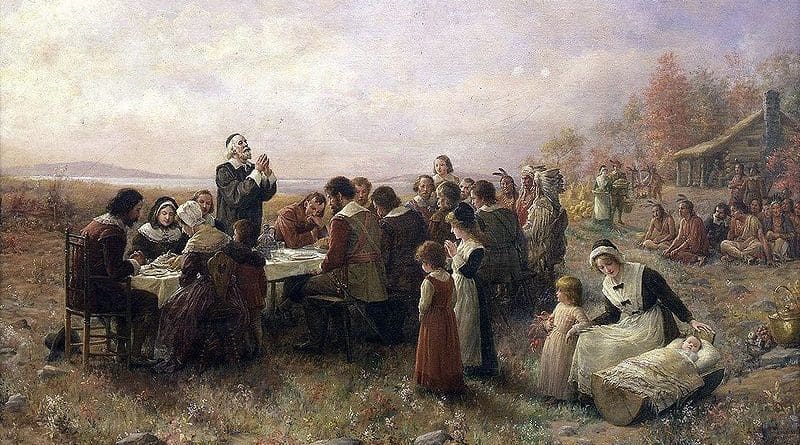What Really Happened At First Thanksgiving
By VOA
By Dora Mekouar
The Pilgrims celebrated their first successful harvest in the fall of 1621 by firing guns and cannons in Plymouth, Massachusetts. The noise alarmed ancestors of the contemporary Wampanoag Nation who went to investigate.
That’s how native people came to be present at the first Thanksgiving, says Ramona Peters, historic preservation officer of the Mashpee Wampanoag Tribe, which suggests that paintings depicting Native Americans sitting down for a bountiful and harmonious meal with colonial families is basically a lie.
“The Wampanoag people, men, were not really sure what they were being told was actually true, so they stayed around for a few days. They camped outside,” says Peters. “So there was a lot of tension as well, all of these men, warriors, were next door in the woods at night in the dark close by.”
While the Wampanoag might have shared food with the Pilgrims during this strained fact-finding mission, they also hunted for food.
What was actually eaten at that first Thanksgiving is far different from the turkey, mashed potatoes and stuffing that grace many holiday tables today, according to experts at Plimoth Plantation, a living history museum in Plymouth, Massachusetts.
“We … know turkey was plentiful in Plymouth Colony, but we don’t know for certain that it was served at the meal,” Plimoth Plantation’s Kate Sheehan told VOA via email. “The likelihood is very strong, though. Mussels, lobster and eel were available as well, and enjoyed by both the English and Wampanoag.”
Plimoth Plantation attempts to replicate the original Plymouth Colony settlement established by the English colonists in the 17th century, and makes educated guesses about what else might have been on the first Thanksgiving table.
“English gardens probably produced cabbages, carrots, cucumbers, colewort (collards), parsnips, turnips, beets, onions, radishes, lettuce and spinach, as well as sage, thyme, parsley, marjoram, fennel, anise and dill,” Sheehan says. “Wampanoag and English women also cultivated beans and squashes, including pumpkins.”
Other foods that would have been available at that time of year include Jerusalem artichokes, wild onions, garlic, watercress, cranberries, Concord grapes and native nuts, including walnuts and chestnuts.
“Native people also dried out-of-season fruits such as blueberries and currants, and added them to dishes throughout the year,” Sheehan says.
Although Americans now celebrate Thanksgiving on the fourth Thursday in November, historians can’t pinpoint the exact date of the very first Thanksgiving.
“We know it took place over three days sometime between mid-September and early November in 1621, and was considered a harvest celebration following a successful planting of multicolored flint corn, or maize,” says Sheehan.
It wasn’t until 1863, during the Civil War, that Thanksgiving became a national holiday. President Abraham Lincoln furthered an idealistic Thanksgiving narrative for strategic reasons.
A woman named Sarah Josepha Hale, the editor of an influential women’s magazine, had a hand in convincing President Lincoln that a national Thanksgiving holiday would help unite the war-torn country.
“It was a socio-political move to try to reunite the North and the South after the Civil War to have this national holiday,” says Peters, of the Mashpee Wampanoag Tribe. “It was their brainchild to have this national holiday called Thanksgiving, and its popularity grew through time, but it was actually a pretty smart move to establish something to unite families. During the Civil War, a lot of families actually split down the middle, brothers against brothers.”
Today, Native Americans commemorate Thanksgiving in different ways. Some consider it a day of mourning given the rapid colonization and displacement of their people. Others gather with their families, but the Pilgrims aren’t on their minds.
Peters says native people celebrate a number of thanksgivings throughout the year, at times such as when certain crops come in or a particular fish returns to spawn. Giving thanks is a big part of the Wampanoag members’ spiritual life, she adds.
The tribe, also known as the “People of the First Light,” will have a number of reasons to give thanks this year.
“On a tribal level, we have a chief who’s 98 years old and we’ll give thanks for him still being with us and willing to lead us as a traditional leader,” Peters says. “We will be thankful for the land that is in our care, for the newborn babies into our tribe. We live by the ocean, so we’re First Light people so we give thanks to the bay.”

